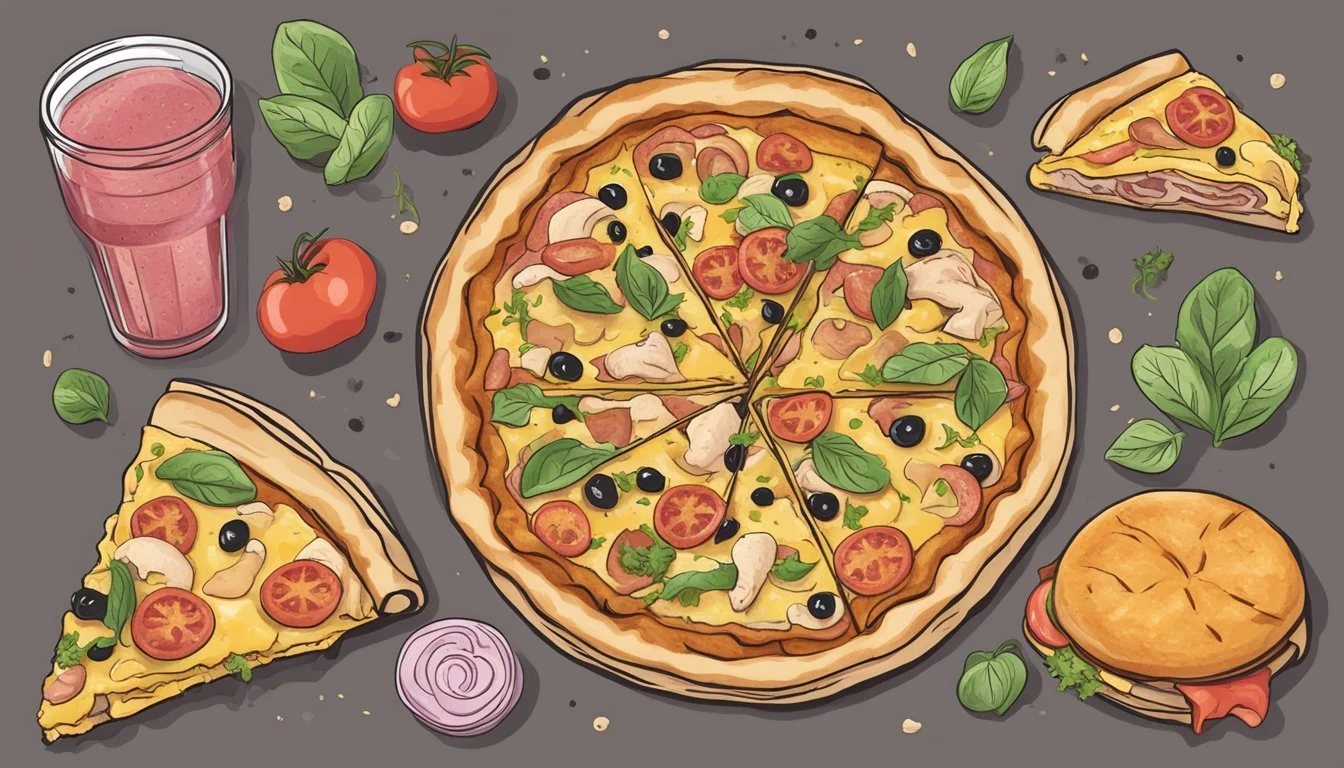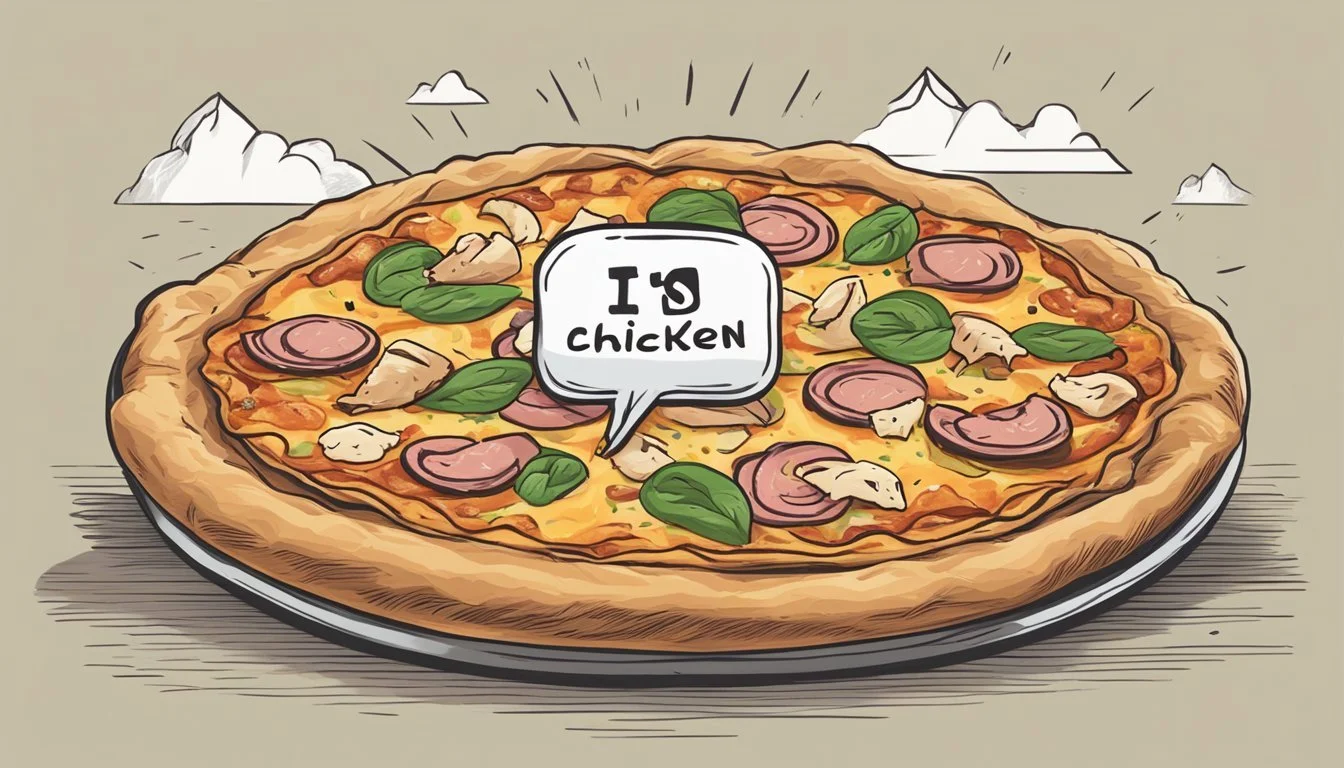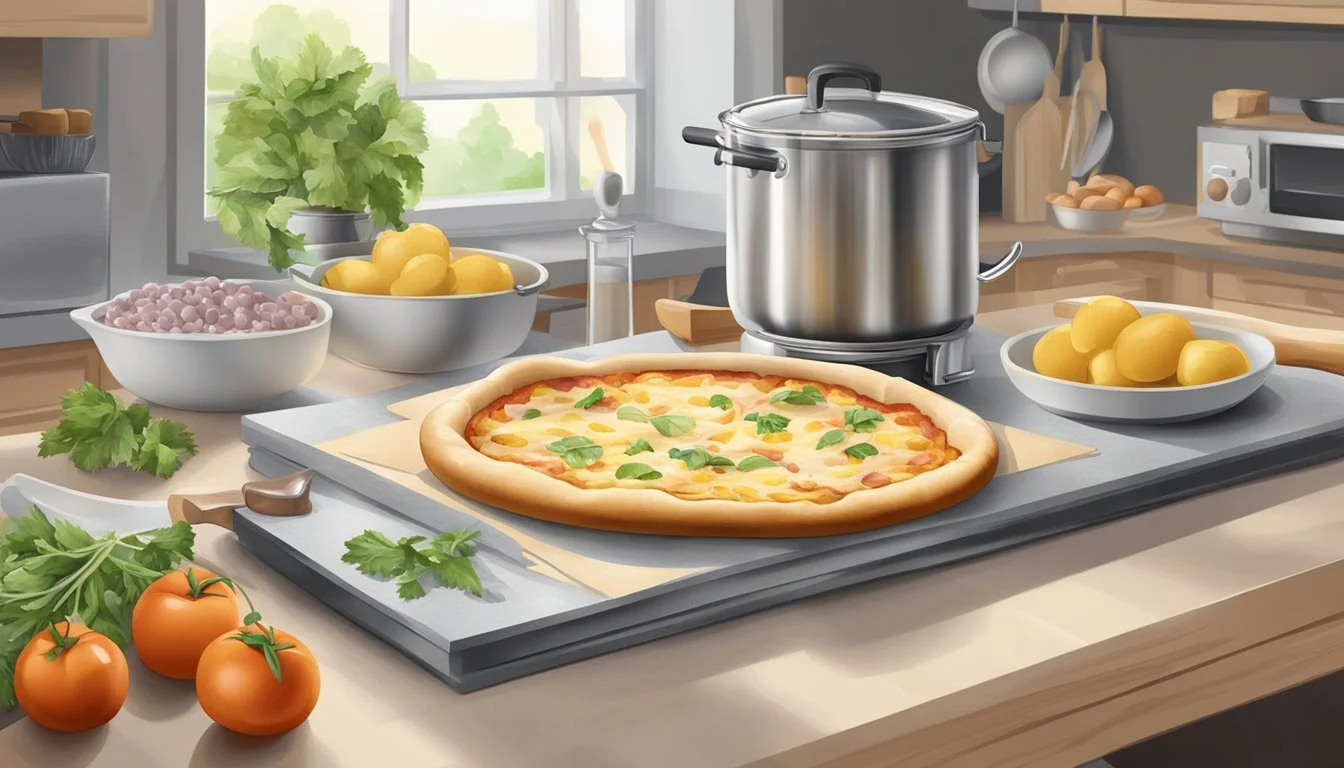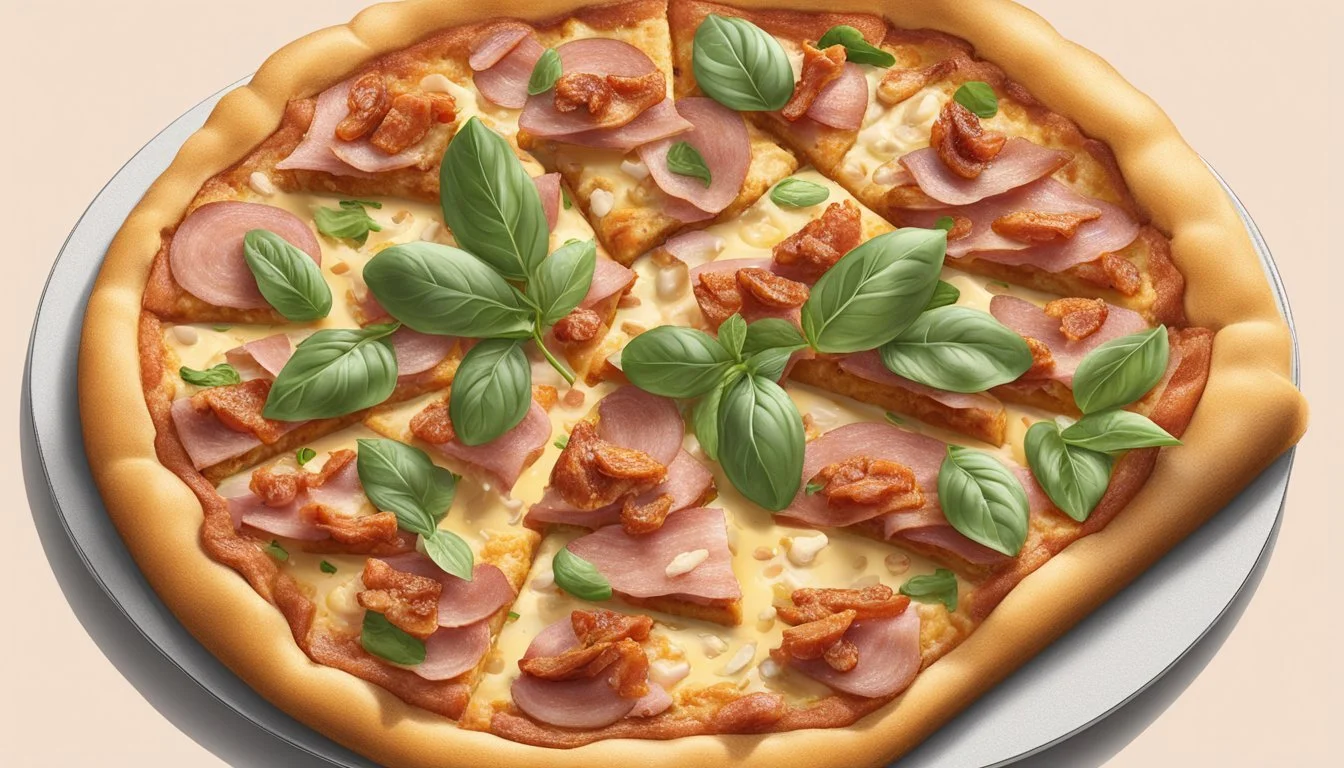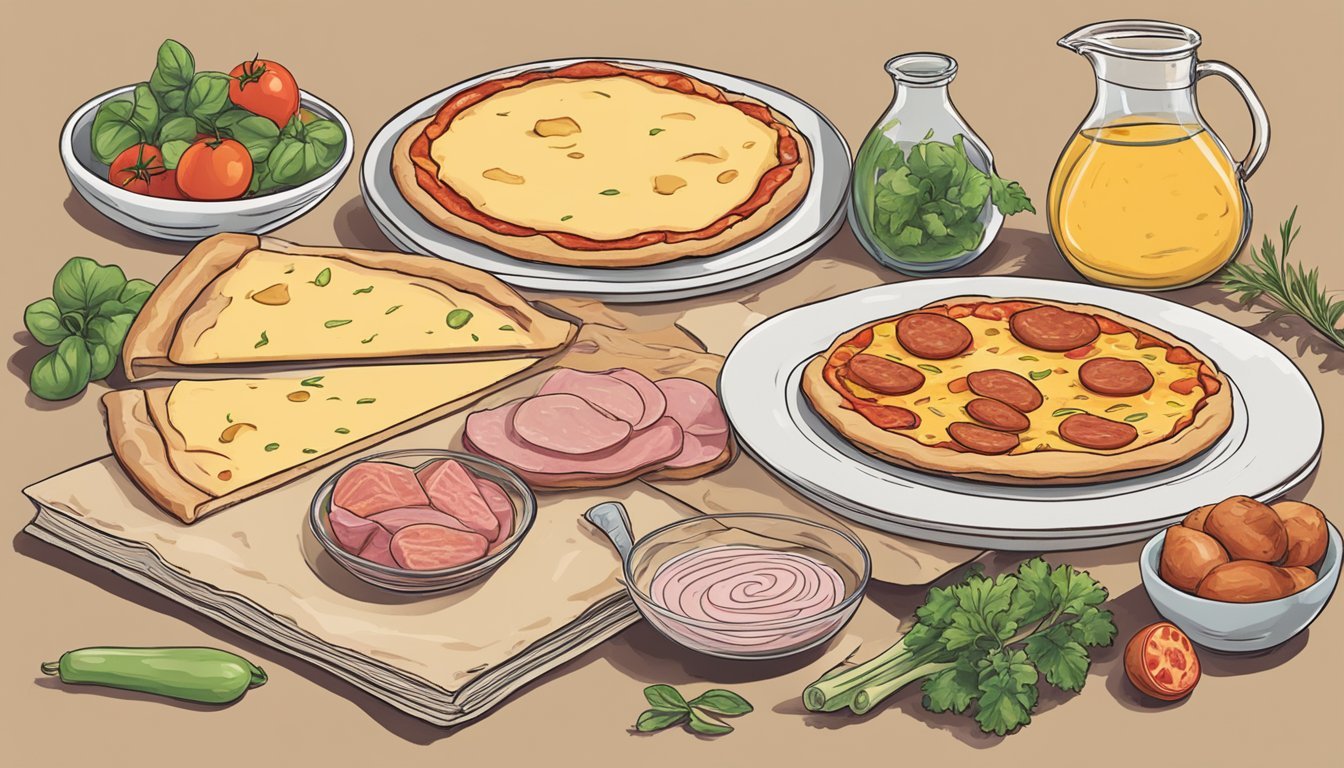Is Chicken Cordon Bleu Pizza Vegan?
Understanding Ingredient Substitutes
Chicken cordon bleu pizza (What wine goes well with pizza?) merges the classic flavors of the traditional chicken cordon bleu (What wine goes well with chicken cordon bleu?) dish—chicken, ham, cheese, and a breaded coating—into a delightful pizza variant. Typically, this indulgent pizza is far from vegan due to its use of animal products. However, culinary innovation has led to the creation of vegan substitutes that mimic these flavors and textures, allowing for a plant-based version of this popular fusion dish.
The question at hand is whether chicken cordon bleu pizza can align with a vegan diet without compromising the essence of its original flavor profile. It is indeed possible to craft a vegan-friendly version by substituting the central ingredients with plant-based alternatives. For instance, chicken can be replaced with tofu, seitan, (What wine goes well with seitan?) or prepared vegan chicken substitutes. Vegan cheeses can be utilized in place of traditional dairy cheese, and vegan ham made from plant proteins can stand in for pork ham. The challenge lies in ensuring that these substitutions harmoniously replicate the taste and satisfaction that the classic non-vegan version provides.
While the concept of veganizing a chicken cordon bleu pizza might not convince purists of the dish, it offers a creative culinary exploration for those seeking to indulge in familiar flavors in line with a plant-based diet. Manufacturers and home cooks alike are increasingly providing options to make such innovative dishes accessible to a broader audience interested in vegan alternatives for conventional offerings.
Understanding Veganism
In assessing whether chicken cordon bleu pizza can be vegan, one must first grasp the core tenets of veganism. This includes its definition and adherence to strict plant-based ingredients.
Definition and Principles of Veganism
Veganism is a lifestyle choice that excludes all forms of animal exploitation and cruelty, encompassing diet, clothing, or any other purpose. The dietary aspect of veganism abstains from all animal-derived products, including meat, dairy, eggs, and honey. The principles of veganism promote the use of foods and materials that are not of animal origin.
Vegan Cheese: Veganism allows for non-dairy cheese alternatives made from plant sources such as nuts or soy.
Vegan Ham: Plant-based substitutes for ham, such as those crafted from jackfruit, seitan, or legumes, typify vegan alternatives to traditional meats.
Dairy-Free: True to vegan values, dairy-free indicates a product contains no milk, butter, or any other dairy ingredients.
Plant-based: While generally synonymous with vegan, this term can sometimes include a broader range of diets that focus on plants but may include small amounts of animal products; in strict veganism, this is not permissible.
Origins of Chicken Cordon Bleu
Chicken Cordon Bleu is a dish with European roots, known for its tender chicken, rich ham, and melted cheese.
Traditional Ingredients
Chicken Cordon Bleu traditionally consists of:
Chicken breast (What wine goes well with chicken breast?): Pounded flat
Ham: Thinly sliced
Cheese: Typically Swiss cheese, also sliced thin
These ingredients are layered together, rolled into a roulade, breaded, and then either fried or baked.
Cultural Significance
Chicken Cordon Bleu is a variant of the earlier European dishes such as Veal Kiev and Veal Cordon Bleu, which appeared in Paris during the late 19th century. The dish represents a melding of culinary traditions, often associated with French haute cuisine yet embraced globally for its satisfying combination of flavors and textures. The swapping of veal for chicken and adaptation of the dish in various countries exemplifies its cultural impact.
Pizza Basics
In understanding the essentials of pizza making, one must recognize its foundational components and the ingredients that comprise its base layer. The anatomy of a pizza and the typical components of pizza dough are fundamental knowledge for any pizza enthusiast or culinary explorer.
Anatomy of a Pizza
The fundamental structure of a pizza consists of several layers that contribute to its overall flavor and texture. These layers include:
The Crust: Serves as the base and is arguably the most critical component that can make or break the pizza experience.
The Sauce: Spread over the crust, it adds moisture and acidity. Tomato sauce is the most common, but variants like Alfredo can be used.
The Toppings: Including proteins, vegetables, and sometimes fruits, they provide the distinct character to the pizza.
The Cheese: Acts as a binding agent for the toppings and adds a layer of richness and flavor.
Common Pizza Dough Ingredients
Crafting the perfect pizza crust starts with a selection of basic, yet pivotal ingredients. These components must be balanced to achieve an ideal dough texture and taste.
The fundamental ingredients include:
Flour: Typically high-protein flour like '00' or bread flour is used for its gluten strength, giving the crust chewiness and structure.
Water: Activates the gluten and hydrates the flour, playing a crucial role in the dough's consistency.
Yeast: A leavening agent, often active dry or instant, which facilitates dough rise through fermentation, producing CO2.
Olive Oil: Adds moisture and flavors the crust, while also helping to tenderize the dough.
Salt: Enhances flavor and regulates yeast activity, impacting the rate of fermentation.
Sugar (optional): Can be used to offer slight sweetness and to brown the crust due to caramelization during baking.
The ingredients are typically mixed, then kneaded to develop the gluten network, resulting in a dough that is both stretchy and airy.
Transforming Classics to Vegan
When reimagining classic dishes like chicken cordon bleu pizza for a vegan audience, chefs focus on replicating familiar flavors and textures with plant-based ingredients. This transformation is crucial to delivering a satisfying experience without the use of animal products.
Veganizing Meat
The essence of chicken cordon bleu lies in its succulent meat, traditionally chicken and ham. To create a vegan version of this, chefs often use seitan or tofu as bases for vegan chicken, infusing them with a rich blend of spices and seasonings to emulate the savory depth of poultry. Vegan ham is crafted similarly, with ingredients like vital wheat gluten and chickpea flour, flavored with smoky elements to mirror the typical taste of actual ham. The preparation might include marinating these plant-based proteins in vegan chicken broth or soy sauce to achieve the desired umami flavor profile.
Vegan Cheeses and Their Qualities
Vegan cheese plays a pivotal role in creating a convincing cordon bleu experience. Dietary preferences dictate the choice between nut-based cheeses, such as those derived from cashews or almonds, and those made from soy or root vegetable starches. Plant-based ham and vegan cheese must melt well and have a creamy consistency to mimic the characteristic mouthfeel of their dairy and meat counterparts.
Types of Vegan Cheese Qualities Common Uses Nut-Based Rich, creamy Pizzas, sauces Soy-Based Stretchy, melts well Sandwiches, toppings Starch-Based Stable at high temperatures Baking, grilling
The success of a vegan chicken cordon bleu, particularly on pizza, is measured by how well these vegan alternatives work in concert to deliver the traditional dish's appeal in a completely plant-based format.
Making Chicken Cordon Bleu Pizza
Chicken Cordon Bleu Pizza combines the creamy richness and the classic flavors of the traditional Chicken Cordon Bleu with the beloved Italian staple. The preparation involves cooking chicken, layering with ham and cheese, and baking on pizza dough to perfection.
Recipe Overview
The pizza recipe calls for:
Chicken breast: Cooked and sliced.
Ham: Deli-sliced ham is a convenient choice.
Mozzarella cheese: Provides the necessary meltiness.
Pizza dough: Either homemade or store-bought.
Alfredo sauce and Dijon mustard: For the base sauce.
One requires a skillet for cooking the chicken, and a baking sheet lined with parchment paper to bake the pizza.
Step-by-Step Cooking Process
Preparation:
Preheat the oven—350°F (177°C) for a softer crust or 400°F (204°C) for a crisper one.
In a skillet, cook the chicken breast until fully done, then slice it into thin pieces.
Assembling the Pizza:
Roll out the pizza dough onto a parchment-lined baking sheet.
Mix Alfredo sauce and Dijon mustard; spread over the dough as the base.
Layering:
Layer the cooked chicken slices and ham over the sauce.
Top liberally with shredded mozzarella cheese.
Baking:
Bake in the preheated oven for 10-15 minutes or until the cheese is bubbly and golden.
Slice the baked pizza into equal portions and serve hot.
Customizing Your Pizza
Customizing a pizza allows diners to cater to their specific dietary needs and flavor preferences. Chicken cordon bleu pizza traditionally includes meats and cheeses, but with a few alterations, it can be adapted to suit different dietary requirements.
Variations and Toppings
To begin customizing a chicken cordon bleu pizza, one must consider the toppings. Traditional toppings include:
Sauce: A rich, creamy sauce such as Alfredo or a mixture of melted butter and cream is customary. To adapt, one might choose a vegan Alfredo sauce.
Cheeses: Swiss and mozzarella cheeses are staples on a chicken cordon bleu pizza. Vegan versions of shredded Swiss and mozzarella can substitute for their dairy counterparts.
Proteins: Sliced chicken and ham can be replaced with plant-based alternatives to cater to a vegan diet.
Extras: Crisp bacon, aromatic thyme, and bold Dijon mustard can enhance the flavor profile. Vegan bacon and mustard, free from animal-derived ingredients, are excellent options for those seeking to preserve the character of the pizza without the use of animal products.
In addition, one may sprinkle breadcrumbs or panko breadcrumbs atop the pizza for added texture. For a gluten-free option, ensure that these crumbs are certified gluten-free.
Gluten-Free and Allergy-Friendly Options
When crafting a gluten-free version of chicken cordon bleu pizza, every ingredient needs scrutiny. Key substitutions include:
Gluten-Free Crust: Start with a gluten-free pizza base, available in many stores or homemade.
Allergy-Friendly Cheese: Choose gluten-free and dairy-free Swiss and cheddar cheese alternatives.
Sauce Modifications: Assure that the cream-based sauce or any mustard used is gluten-free; sauces can be thickened using gluten-free flour if needed.
Toppings: Replace toppings with gluten-free variants; for instance, opt for gluten-free panko crumbs.
Careful selection of ingredients ensures a pizza that both aligns with dietary needs and satisfies the taste buds.
Nutritional Profile of Chicken Cordon Bleu Pizza
The nutritional profile of Chicken Cordon Bleu Pizza is multifaceted, encompassing a range of macros and caloric content. This section dissects its nutrition facts, providing essential data for health-conscious individuals.
Macronutrient Breakdown
Calories: A standard slice of Chicken Cordon Bleu Pizza contains a significant amount of calories due to its rich toppings and cheese.
Total Fat: The pizza is high in total fat, with saturated fat being a notable component due to the cheese and meat.
Cholesterol: Cheese and meat toppings contribute to the cholesterol content.
Sodium: High sodium levels are present, primarily from the cured meats and cheese.
Carbohydrates: The crust contributes a substantial carbohydrate count, which can vary depending on the thickness and recipe used.
Fiber: Fiber is present but in lower quantities, primarily from the dough and any included vegetables.
Protein: The chicken and ham toppings provide a good source of protein, making the pizza a filling meal option.
Analyzing Caloric Content
The calorific value of a Chicken Cordon Bleu Pizza slice can be expected to be high, as it combines energy-dense foods like cheese, cured meats, and dough. The specific caloric content will vary based on the size of the slice and the proportions of the ingredients. Here's a simplification of the caloric contribution:
Cheese & Meat: The combination of chicken, ham, and cheese often accounts for a significant portion of the calories.
Alfredo Sauce: If used as a base, contributes additional fats and calories.
Crust: The thickness and type of crust directly influence total caloric intake.
Consuming a slice of Chicken Cordon Bleu Pizza can add a substantial amount of calories and saturated fat to one's daily dietary intake, while contributing to protein and carbohydrate needs. However, the exact nutritional values will be determined by the specific recipe and serving size.
Kitchen Prep and Equipment
When creating a vegan version of chicken cordon bleu pizza, the correct kitchen prep and equipment are essential. This section guides you through the necessary utensils and steps to prepare for baking.
Required Cooking Utensils
To make vegan chicken cordon bleu pizza, the following utensils are essential:
A high-speed blender or food processor: Vital for creating a smooth seitan base, which acts as the chicken substitute.
A large mixing bowl: Needed to combine dry ingredients, such as vital wheat gluten and seasonings.
Measuring cups and spoons: For precise ingredient amounts, ensuring consistency in flavour and texture.
A kitchen scale: Helpful for measuring ingredients, especially when kneading the seitan into the proper consistency.
A rolling pin: To evenly flatten the seitan "chicken" and the pizza dough into the desired shape and thickness.
A knife or pizza cutter: For slicing ingredients and the finished pizza.
Prepping for Baking
Prior to assembling and baking the pizza:
Allow the seitan to rise if the recipe calls for it, which can improve the texture.
Preheat the oven with a pizza stone in place, which helps achieve a crispy crust. If unavailable, a baking sheet lined with parchment paper is an alternative.
Prepare the countertop by cleaning it thoroughly and lightly dusting with flour to prevent sticking while kneading the pizza dough into balls.
Lightly coat the dough with cooking spray before letting it rise to prevent it from drying out.
Have a baking sheet or pizza peel ready to transfer the pizza to the oven.
By following these utensil guidelines and prep steps, the chef will be set for baking a delicious and cruelty-free twist on a classic dish.
Serving and Presentation
Once the chicken cordon bleu pizza is prepared, serving it properly enhances its appeal and taste. The presentation should showcase the pizza's crispy texture and integrate quick, simple touches that elevate the experience.
Cutting and Plating
A pizza cutter or sharp chef's knife is essential for slicing through the pizza to maintain the crunch of the crust and the integrity of toppings. Cutting should be done swiftly after the pizza is out of the oven to ensure that each slice has a mix of the tender, savory toppings and the crispy base. Serve the slices on a warm plate to keep the pizza delicious until it reaches the table.
Equipment: Pizza cutter/chef’s knife
Temperature: Serve on warm plates
Garnishes and Final Touches
A sprinkle of freshly chopped parsley can add a pop of color and a mild herby flavor that complements the richness of the pizza. It should be used sparingly to avoid overpowering the main dish. A light drizzle of olive oil may also be applied for an added sheen and a subtle depth of flavor. These final touches should be easy to apply and contribute to the visual appeal and taste of the dish.
Garnish: Fresh parsley, Olive oil drizzle
Purpose: Color, Flavor, Appeal
Tips and Tricks for the Perfect Pizza
The key to crafting the perfect pizza, especially when considering a specialty pizza like chicken cordon bleu, lies in the quality of the crust and a well-balanced flavor profile. Here are specific techniques to ensure excellence in these areas.
Achieving the Ideal Crust
Texture: A perfect crust is both crispy and chewy. Preheating the oven to an appropriately high temperature is crucial. Use a pizza stone or baking sheet to mimic the effect of a pizza oven.
Ingredients: Incorporate a mix of Italian seasoning to infuse the dough with a herby undertone, enhancing the overall savoriness.
Thickness: Consistency in thickness is vital to an even bake. Utilize a rolling pin or press the dough with the heel of your hand to achieve the desired thickness – not too thick, not too thin.
Balancing Flavors
Boldness vs. Nuance: Balance strong flavors like garlic powder and onion powder with the creaminess of vegan cheese. This creates a harmony between zest and subtlety.
Layering: Construct your pizza by thoughtfully layering ingredients:
Spread the vegan cheese mixture onto the crust.
Add vegan 'chicken' slices.
Sprinkle pepper and additional seasonings as needed to taste.
Complementing Tastes: Herbs like Italian seasoning can complement the savory notes of faux chicken and vegan ham. Be mindful of the seasoning to ensure all flavors are well-represented without overpowering each other.
Vegan Substitutes for Chicken Cordon Bleu Pizza
Creating a vegan version of chicken cordon bleu pizza requires careful selection of plant-based meats and cheese alternatives to mimic the traditional flavors and textures. The key is to find the right balance of savory and creamy elements without using any animal products.
Plant-Based Meats and Textures
For the chicken aspect of the pizza, seitan is an excellent substitute due to its chewy texture and protein content. Seitan can be homemade or purchased ready-made and flavored with a blend of spices, including garlic and onion powder, and black pepper. Seitan absorbs flavors well, particularly when it is infused with a vegan chicken broth and soy sauce mixture.
Vegan ham substitutes are widely available and can be selected based on textural preference, whether one desires a smoky flavor or a mild one. These can typically be found sliced, making them easy to layer on a pizza. Smoked paprika can be sprinkled onto these plant-based meats to enhance the smokiness and depth.
Cheese Alternatives and Vegan Sauces
The cheesy component of cordon bleu can be recreated using vegan cheese options made from ingredients like cashews, almonds, or soy. They come in varieties similar to traditional cheeses, such as mozzarella and Swiss — both of which would be suitable for this pizza. Here are some specific vegan cheese substitutes you can consider:
Slices: Perfect for easy layering.
Shreds: Melt nicely and evenly over toppings.
Another important factor is the creaminess typically provided by sauces in a chicken cordon bleu dish. Vegan mayo combined with nutritional yeast creates a rich base that can take the place of creamy sauces usually made with dairy. The nutritional yeast not only thickens the texture but also imparts a cheesy, umami flavor that enhances the overall taste profile of the pizza.
The Cultural Implications of Veganizing Traditional Dishes
Veganizing traditional dishes such as chicken cordon bleu has led to diverse reactions within society and has had an intriguing impact on culinary tradition. This transformation challenges both the perception and the long-established culinary practices.
Perception and Acceptance in Society
Society’s reception of vegan cordon bleu is varied. On one hand, it garners attention for being an innovative and health-conscious alternative to a classic meal. However, it can also face scrutiny from culinary purists who may see the modification of traditional dishes such as cordon bleu as inauthentic. The acceptance of vegan cordon bleu often hinges on how comparable the taste and presentation are to the original non-vegan version.
The Impact on Culinary Tradition
Culinary traditions are dynamic; they evolve with time and culture. Introducing vegan cordon bleu into the mix has the potential to enrich culinary traditions by demonstrating that a meal can be both delicious and plant-based. It can encourage chefs to explore new frontiers in taste and texture, possibly leading to new traditions in their own right. Nevertheless, the recipe's adaptation must respect the essence of the original to be genuinely embraced as part of the culinary lineage.
Advanced Cooking Techniques
Developing a vegan version of chicken cordon bleu pizza demands proficient skills in alternative ingredient cooking. This section divulges into the intricacies of pan-frying vegan alternatives and mastering baking temperatures to achieve the perfect texture and taste.
Pan-Frying Vegan Alternatives
When crafting vegan chicken, chefs often utilize ingredients like tofu or seitan, which mimic the texture of animal protein. Pan-frying is critical to achieve the characteristic golden crust and savory flavor profile.
Key Steps for Pan-Frying Vegan Chicken:
Coat the vegan chicken alternative in a mixture of flour, panko breadcrumbs, and spices to enhance the texture.
Heat a generous amount of oil in a pan—enough to cover the base.
Once the oil is hot, carefully place the breaded vegan chicken into the pan.
Pan-fry until each side is crisp and golden brown, roughly 3-4 minutes per side, depending on thickness.
Mastering Baking Temperatures
Proper baking is vital for a well-composed vegan chicken cordon bleu pizza. A consistent oven temperature ensures that the assembled pizza cooks evenly, melding the flavors together without drying out the vegan alternatives.
Optimal Baking Temperatures:
Pizza Component Temperature Duration Base pizza crust Preheat to 375°F (190°C) Bake until lightly golden Added vegan chicken cordon bleu topping Continue at 375°F (190°C) Bake until topping is hot and cheese substitute is melted
It is important to note that vegan cheese alternatives do not behave like dairy cheese. They may require lower temperatures or a shorter baking time to avoid becoming too firm or losing their creaminess, as they do not contain heavy cream or other dairy components.
Meal Planning and Nutrition
Creating a satisfying vegan version of chicken cordon bleu pizza requires attention to both flavor and nutritional content. This dish can be a part of a balanced plant-based diet and offer essential nutrients typically found in its non-vegan counterpart.
Incorporating Into a Balanced Diet
A vegan chicken cordon bleu pizza can easily fit into a balanced diet with thoughtful ingredient selection. Protein, an important macronutrient for muscle repair and growth, can be derived from plant-based sources like seitan or tofu used in vegan chicken alternatives. Combining these with whole grain crust options increases the fiber content, promoting better digestion and satiety.
The challenge is to keep the dish low in saturated fats and sodium, which can be managed by opting for less processed vegan cheeses and controlling portion sizes. It's important for individuals to complement this pizza with vegetables and fruits to round out the meal.
Nutritional Advantages of Vegan Choices
Vegan alternatives in a chicken cordon bleu pizza can offer several nutritional advantages.
Nutritional Yeast: Often used to create a cheesy flavor, nutritional yeast is fortified with vitamins and minerals, such as B12, which is crucial for nerve function and often lacking in vegan diets.
Plant-based Proteins: Sources like seitan and tofu not only mimic the texture of chicken but are also rich in protein and contain less saturated fat than their animal-based counterparts.
One must be mindful of the vitamins and minerals that could be less available in a vegan diet, such as iron and calcium. These can be compensated for with fortified products or by including a variety of other nutrient-rich plant-based foods in the diet.
Storing and Reheating Leftovers
When it comes to leftover chicken cordon bleu pizza, maintaining the quality of the gooey cheese, the integrity of the crispy crust, and the overall freshness is crucial for enjoyable reheating.
Best Practices for Preservation
Storing Leftover Pizza:
Cooling: Leftovers should be cooled to room temperature quickly to prevent bacterial growth.
Packaging: Wrap the pizza slices individually in plastic wrap or aluminum foil to protect from air exposure and odor absorption.
Refrigeration: Store wrapped slices in an airtight container or resealable plastic bag and place in the refrigerator. The items should be consumed within 2-3 days for optimum freshness.
Reheating Without Compromising Quality
Preheat the oven to 350°F (175°C).
Baking Sheet: Place the pizza slices on a baking sheet lined with parchment paper.
Aluminum Foil Tent: Optionally, create a tent over the pizza with aluminum foil to prevent the cheese from burning.
Reheat: Warm in the oven for 5-10 minutes or until the cheese is gooey and the dough is heated through.
Microwave Reheating Method:
Damp Paper Towel: Place a damp paper towel over the slice to prevent the crust from getting too tough.
Reheat: Use a microwave-safe plate and heat on medium power in 30-second intervals, checking for desired warmth and crispiness.
To maintain the pizza's moisture and avoid a chewy texture, reheating should be monitored closely, especially when using the microwave.
Economic Considerations
When venturing into the world of vegan chicken cordon bleu pizza, it's prudent to weigh the economic implications. The cost of homemade pizza versus store-bought and the price variance in vegan substitutes play a pivotal role in a consumer's decision.
Cost-Effectiveness of Homemade Pizza
Homemade vegan chicken cordon bleu pizza can be markedly more cost-effective than purchasing from a restaurant. The initial investment in ingredients such as flour for the dough, vegan mozzarella, and vegan cheddar, may be higher; however, these purchases can yield multiple pizzas. A basic cost comparison illustrates the potential savings:
Flour (for dough): $3 for 5 lbs, yields approximately 15 pizza bases.
Vegan Mozzarella: $5 for 8 oz, sufficient for 4 pizzas.
Vegan Cheddar: $5 for 8 oz, sufficient for 4 pizzas.
The cumulative cost for enough dough and cheese to create 4 pizzas would average around $18, or $4.50 per pizza, excluding other toppings and the cost of making the vegan chicken substitute.
Comparing Prices of Vegan Ingredients
The prices for vegan ingredients can be higher than their non-vegan counterparts, which impacts the overall cost of the pizza. Here's a comparison:
Vegan Chicken Substitute: Prices can vary, but it might be approximately $6-8 for enough to top several pizzas.
Dairy Cheese (for reference): Traditional mozzarella and cheddar might cost $2-4 per 8 oz, which is cheaper than vegan cheese options.
Shoppers must be attentive to the fluctuating prices and available alternatives. Bulk purchases and sale items can significantly reduce the cost of vegan ingredients, making vegan pizza more affordable.
Exploring Related Cuisines
In the realm of fusion dishes, especially those that intersect with vegan dietary preferences, pizza often acts as a canvas for cultural and culinary innovation. This versatility creates an opportunity to craft internationally influenced, plant-based options like the chicken cordon bleu pizza.
Other Fusion Dishes
Fusion cuisine combines elements from different culinary traditions. Beyond vegan chicken cordon bleu pizza, fusion dishes delight with creative interplays such as:
Taco Pizza: Traditional Mexican flavors like beans, salsa, and avocado meet the classic Italian platform.
Curry Pizza: Featuring rich, aromatic spices and plant-based alternatives to typical meats found in South Asian cuisine.
Sushi Pizza: A Japanese-Italian mixture with rice bases, topped with vegan seafood alternatives and wasabi-infused sauces.
Global Influences on Pizza
Pizza, while rooted in Italian tradition, has been adapted globally using locally available ingredients and culturally significant dishes. International influences reshape the concept of pizza in various ways:
Italian Basis: Pizza dough and tomato sauce, coupled with innovations in vegan cheese, create a familiar foundation.
American Adaptations: The U.S. spurred the creation of diverse pizza types, using different crusts, such as thick Chicago-style or thin New York-style.
Asian Twists: Countries like Japan introduce unique toppings like seaweed and teriyaki-glazed plant-based proteins.
In examining these cuisines, it becomes clear that recipes continuously evolve. Chefs and home cooks alike reinterpret culturally significant dishes through the lens of international cuisine, leading to novel and exciting cooking expressions.
Food Safety and Handling
When preparing a chicken cordon bleu pizza, particularly a vegan version, it is crucial to maintain strict food safety and handling standards to prevent foodborne illnesses and guarantee a safe dining experience.
Preventing Cross-Contamination
To prevent cross-contamination:
Use separate cutting boards and utensils for plant-based and animal-based items if both are used in a kitchen. Even when making a vegan pizza, this step ensures no residue from non-vegan products like traditional chicken or diced ham contaminates the vegan components.
Store ingredients properly: Keep vegan and non-vegan products in different containers or shelves in the refrigerator. Any chicken or chicken tenders, if used in the same kitchen, should be stored below plant-based items to prevent juices from dripping down.
Safe Cooking Temperatures
Adhering to safe cooking temperatures is vital:
For non-vegan versions of the pizza, any chicken element must reach an internal temperature of 165°F (74°C). This can be checked using a food thermometer.
Vegan meat substitutes do not harbor the same bacteria as chicken, but they should be cooked according to package instructions, often to a comparable temperature, to ensure optimal texture and flavor.
Cooking at these temperatures while incorporating safe food practices, like using kosher salt for flavoring and preservation, contributes to creating a meal that's not only delicious but also safe for consumption.
Environmental and Ethical Considerations of Food Choices
Food choices have far-reaching impacts on both the environment and animal welfare. Particularly, the choice between consuming meat-based products like traditional chicken cordon bleu and plant-based alternatives such as vegan cordon bleu plays a significant role in these considerations.
The Effects of Meat Consumption
Meat consumption, specifically chicken production, necessitates considerable water and feed input, leading to a high environmental footprint. Poultry farming for products like chicken cordon bleu is associated with various environmental detriments:
Resource Use: It requires significant amounts of water and cereal grains to raise chickens.
Greenhouse Gases: The farm operations and manure management produce methane and nitrous oxide.
Land Alteration: To accommodate farms, forests, and other habitats are often cleared, which affects biodiversity.
Benefits of a Vegan Diet on the Environment
Transitioning towards a vegan diet, which excludes animal products such as those in cordon bleu, offers several environmental benefits:
CO₂ Reduction: Plant-based alternatives drastically reduce carbon emissions compared to animal-based counterparts.
Conservation of Water: Vegan dishes like vegan cordon bleu conserve water since plant-based protein production requires less water than animal protein.
Land Preservation: A vegan diet supports lesser land use, avoiding deforestation and habitat destruction.
The Future of Plant-Based Cuisine
The plant-based cuisine sector is evolving rapidly, with ingredient innovation and culinary trends aligning with the growing demand for vegan options that provide both flavor and variety.
Innovation in Vegan Cooking
Chefs and food scientists are working hand in hand to craft novel plant-based recipes. They are experimenting with ingredients like chickpeas and broccoli, harnessing their versatility to replace traditional animal-based components. Poultry seasoning, typically a blend of herbs and spices, is being reformulated to complement plant-based proteins, providing the familiar flavors without the use of actual poultry. With developments in fermentation and aging, Chao creamery is propelling this innovation forward, offering a range of non-dairy cheeses that melt and stretch similar to traditional cheeses, making them ideal for vegan pizzas and other dishes where cheese is an essential element.
Predictions for Vegan Culinary Trends
In the foreseeable future, vegan cuisine is expected to focus on plant-based alternatives that don't compromise on taste or texture. Pioneers predict that vegan companies will continue to expand their offerings, creating products that challenge the status quo of the plant-based market. These trends include:
Broccoli: Rethinking how this green vegetable can be the star of a dish, not just a side.
Plant-Based Poultry: Enhanced by custom poultry seasoning, delivering flavors that mimic those of traditional chicken dishes.
Chao Creamery: Their vegan cheese products are anticipated to become staples in both home cooking and restaurant dishes.
Chickpeas: They are likely to become more prevalent due to their high protein content and adaptability in forms like flours, butters, and even plant-based meats.
The pathway that plant-based cuisine is carving will undoubtedly lead to a landscape where vegan options are abundant, sophisticated, and indistinguishable from their animal-derived counterparts in terms of satisfaction and enjoyment.
Concluding Thoughts
In assessing whether chicken cordon bleu pizza can be considered vegan, one must first deconstruct the traditional components of this dish. Chicken cordon bleu typically comprises chicken breast, ham, and cheese, which are non-vegan ingredients. However, the creation of vegan chicken cordon bleu utilizes plant-based substitutes to replicate the flavors and textures of the original.
When adapting this concept to pizza, the challenge remains to maintain the essence of cordon bleu within the vegan paradigm. Plant-based chicken substitutes, such as those made from seitan or tofu, can serve as the pizza's protein base. Dairy-free cheese replaces the traditional cheese, and vegan ham crafted from ingredients like wheat gluten or soy can be used in place of regular ham.
The fusion of these elements on a pizza base yields a product that not only aligns with vegan dietary requirements but also resonates with the original dish's taste profile. The success of creating a vegan cordon bleu pizza relies on the careful selection and preparation of these alternative ingredients, providing a culinary experience that adheres to vegan principles while paying homage to the classical dish.
For those seeking authoritative content on vegan adaptations of classic recipes, this examination provides comprehensive information on transforming a chicken cordon bleu pizza into a vegan-friendly option. Readers are encouraged to explore animal-free versions of favorite meals, discovering that with innovation, most dishes can be enjoyed within a vegan lifestyle.


